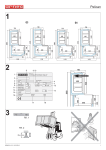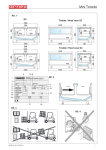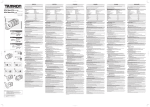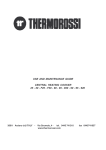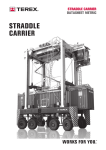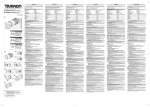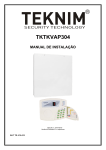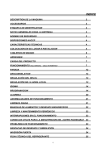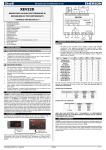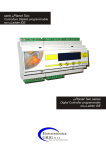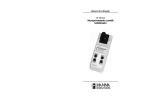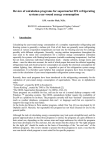Download Osaka 2
Transcript
2030 324 70 H216 494 400 717 70 H203 65 H216 324 717 2160 667 444 350 667 65 H203 324 324 494 75 H216 767 544 450 767 75 H203 544 324 324 444 80 H216 817 594 500 817 80 H203 594 324 324 2030 2160 2030 2160 2030 2160 500 85 H216 867 644 500-550 867 85 H203 644 500-550 2030 2160 450 324 324 400 90 H216 917 694 500-600 917 90 H203 694 500-600 2030 2160 05060127 00 14/02/2012 324 324 350 Osaka 2 Rif. 1 1 Osaka 2 6 Rif. 2 10 8 1 ARNEG S.p.A. VIA VENEZIA 58 - CAMPO SAN MARTINO - PADOVA - ITALY Tel. +39 049 9699333 Fax +39 049 9699444 - [email protected] 2 3 5 9 11 12 14 CODICE ITEM 16 COMMESSA W.SCHED V SBRINAMENTO DEFROSTING SUPERF.ESP. DISPLAY AREA MATRICOLA S/N Hz W W IP MASSA WEIGHT kg 13 m 2 REFRIGERANTE REFRIGERANT CLASSE CLASS ILLUSTRAZIONI ILLUSTRATIONS ABBILDUNGEN ILLUSTRATIONS ILLUSTRACIONES ɂɅɅɘɋɌɊȺɐɂɂ Rif. ILLUMINAZIONE LIGHTING 4 7 15 A W ORDINE W.ORD. 17 ANNO YEAR 18 Rif. 4 3 Rif. 7 Max 25mm Rif. 6 Rif. 5 Rif. 8 2 Rif. 9 Rif.10 05060127 00 14/02/2012 Osaka 2 Rif.11 30 cm Rif. 12 Rif. 13 160 kg/m MAX 30°C MAX 30 bar 2 0° 10° passo montante 25mm 25mm upright pitch Rif. 15 Rif. 14 Rif. 17 min 30mm er t wa CHEMICALS Rif. 18 Rif. 16 2 1 L A N 10 mm Prg IO T P aux O HACCP mute aux Set def Rif. 21 Rif. 22 Rif. 19 05060127 00 14/02/2012 Rif. 20 3 Osaka 2 Rif. 23 1460 H2O 700 495 140 670 R404A 900 R404A 1250 900 175 480 1460 H2O 700 937.5 625 1250 900 480 R404A 1460 140 H2O R404A H2O 1250 900 TESTATE/HEAD CASES 140 1673 1506 495 86.5 86.5 H2O 1333 293 900 86.5 1500 86.5 460 140 900 140 R404A 770 595 1875 595 830 770 175 140 830 3750 670 900 H2O 2500 900 937.5 2710 140 1250 700 625 900 830 595 H2 O 835 770 - 820 870 - 920 R404A R404A 1875 140 595 210 545 140 720 R404A 900 175 H2O 545 720 R404A 835 H2O 2500 1875 140 140 1250 937.5 625 900 830 175 495 175 480 770 - 820 870 - 920 545 720 175 670 H2O 210 770 - 820 870 - 920 595 835 140 595 495 670 175 R404A 2500 1875 1250 900 210 H2O R404A H2O 3750 900 R404A 140 H2O 566.5 753 566.5 836.5 1847 1674 86.5 634 900 R404A H2O 86.5 140 830 1875 770 595 545 175 720 2710 3750 2710 900 140 R404A H2O 595 595 770 - 820 870 - 920 566.5 923.5 830 1875 Rif. 24 4 05060127 00 14/02/2012 Osaka 2 Rif. 25 Sout 500 Sout 60 40 A 230 Sdef Sdef Part. A Sin 70 70 Sin Rif. 26 05060127 00 14/02/2012 70° 70° stand-by 70° 5 Osaka 2 Rif. 27 NO ȅȀ Rif. 28 A A 1 120 A 25 B 3 C 6 4 3 5 5 25 B 60 3 6 2 10 9 8 7 1 2 1 MF LF C 5 C A 5 A 05060127 00 14/02/2012 Osaka 2 PORTE SCORREVOLI / SLIDING DOORS Rif. 29 2 1 9 10 3 INOX PORTE A BATTENTE/ HINGED DOORS 2 7 05060127 00 14/02/2012 7 Osaka 2 SCHEMI ELETTRICI STANDARD / STANDARD WIRING DIAGRAMS 1 24 25 PE N 2A 1 24 25 PE N 2A M N 6 N 5 I 4 I 3 ALIMENTAZIONE ILLUMINAZIONE LIGHTING SUPPLY ALIMENTAZIONE CAVI CALDI HEATERS SUPPLY ALIMENTAZIONE TENDE NOTTE NIGHT BLIND SUPPLY ALIMENTAZIONE VENT. DOPPIA CORTINA DOUBLE CURTAIN FANS SUPPLY POWER 2 2 2 ALIMENTAZIONE VENTILATORI EVAPORATORE EVAPORATOR FANS SUPPLY PE 5A 5B PE 5A 5B ALIMENTAZIONE VALVOLA VALVE SUPPLY POWER 3 PE N R1 PE N R1 RESISTENZA SBRINAMENTO DEFROST HEATER ALIMENTAZIONE RESISTENZA SBRIN. DEFROST HEATER SUPPLY PROBES 1 3 4 4 5 5 6 6 Sin 3 SONDA RIPRESA ARIA AIR INLET PROBE 2 Sdef 2 SONDA FINE SBRINAM. END DEFROST PROBE 1 Sout 1 SONDA MANDATA ARIA AIR OUTLET PROBE PROBES 2 3 3 4 4 5 5 5 2 4 2 3 1 2 TRASDUTTORE DI PRESSIONE PRESSURE TRANSDUCER 1 Sev Ssh S SONDA INGRESSO REFRIGERANTE REFRIGERANT INLET PROBE SONDA SURRISCALDAMENTO SUPERHEATING PROBE + - Ssh 1 SONDA SURRISCALDAMENTO SUPERHEATING PROBE SCHEMA DI CABLAGGIO SENZA TERMOSTATI WIRING DIAGRAM WITHOUT THERMOSTATS PE N +=ALIM./SUPPLY -=COMUNE/COMMON S=SEGNALE/SIGNAL VALVOLA SOLENOIDE SOLENOID VALVE EEV PE N VENTILATORI EVAPORATORE EVAPORATOR FANS M S TRASDUTTORE RAZIOMETRICO RATIOMETRIC TRANSDUCER R + - SCHEMA ILLUMINAZIONE VERTICALI TN: D5A15923 WIRING DIAGRAM OF LIGHTING FOR VERTICAL NT: D5A15923 +=ALIM./SUPPLY S=SEGNALE/SIGNAL VENT. DOPPIA CORTINA DOUBLE CURTAIN FANS PE N 2 CAVO/PROLUNGA PLAFONIERA CANOPY CABLE/ADDITIONAL CABLE PE N 1 S mA TRASDUTTORE DI PRESSIONE 4-20 mA PRESSURE TRANSDUCER 4-20 mA + POWER 1 L N 1 2 NON UTILIZZATI NOT USED 5 6 8 05060127 00 14/02/2012 Osaka 2 Schemi elettrici POWER 1 ALIMENTAZIONE ILLUMINAZIONE LIGHTING SUPPLY ALIMENTAZIONE CAVI CALDI HEATERS SUPPLY ALIMENTAZIONE TENDE NOTTE NIGHT BLIND SUPPLY ALIMENTAZIONE VENT. DOPPIA CORTINA DOUBLE CURTAIN FANS SUPPLY POWER 2 PE N 2 2 ALIMENTAZIONE VENTILATORI EVAPORATORE EVAPORATOR FANS SUPPLY PE 5A 5B PE 5A 5B M VALVOLA SOLENOIDE SOLENOID VALVE EEV PE N PE VENTILATORI EVAPORATORE EVAPORATOR FANS ALIMENTAZIONE VALVOLA VALVE SUPPLY PE N R1 PE N R1 RESISTENZA SBRINAMENTO DEFROST HEATER PE S ALIMENTAZIONE RESISTENZA SBRIN. DEFROST HEATER SUPPLY PROBES 1 3 4 4 5 5 6 6 Sin 3 Sdef SONDA RIPRESA ARIA AIR INLET PROBE 2 SONDA FINE SBRINAM. END DEFROST PROBE 2 Sout 1 SONDA MANDATA ARIA AIR OUTLET PROBE 1 +=ALIM./SUPPLY -=COMUNE/COMMON S=SEGNALE/SIGNAL TRASDUTTORE RAZIOMETRICO RATIOMETRIC TRANSDUCER R + - POWER 3 PROBES 2 2 3 3 4 4 5 5 5 2 4 1 3 1 2 3 L 4 N 1 1 CAVO TERM-TERMOSTATO TERMOM.-THERMOSTAT CABLE 2 2 ALIMENTAZIONE POWER SUPPLY CONTATTO TERMOSTATO THERMOSTAT CONTACT 5 5 6 6 7 6 5 TERMOSTATO FINE SBRINAMENTO END DEFROST THERMOSTAT CONTATTO TERMOSTATO THERMOSTAT CONTACT 1 2 8 7 8 230VAC L N CAREL IR**** 1 2 3 4 ALIMENTAZIONE POWER SUPPLY 3 4 1 2 3 4 5 6 DI 9 10 11 12 05060127 00 14/02/2012 TRASDUTTORE DI PRESSIONE PRESSURE TRANSDUCER Ssh S Sev SONDA SURRISCALDAMENTO SUPERHEATING PROBE + - Ssh SONDA INGRESSO REFRIGERANTE REFRIGERANT INLET PROBE 1 SONDA SURRISCALDAMENTO SUPERHEATING PROBE SCHEMA DI CABLAGGIO CON TERMOSTATI E SONDE STANDARD (NTC 10K 25°C) SUL CONNETTORE PROBES 1 WIRING DIAGRAM WITH THERMOSTATS AND STANDARD PROBES (NTC 10K 25°C) ON PROBES 1 CONNECTOR 1 24 25 PE N 2A M 1 24 25 PE N 2A PE N 6 N 5 I 4 I 3 PE N 2 +=ALIM./SUPPLY S=SEGNALE/SIGNAL SCHEMA ILLUMINAZIONE VERTICALI TN: D5A15923 WIRING DIAGRAM OF LIGHTING FOR VERTICAL NT: D5A15923 S mA TRASDUTTORE DI PRESSIONE 4-20 mA PRESSURE TRANSDUCER 4-20 mA + VENT. DOPPIA CORTINA DOUBLE CURTAIN FANS PE N 1 CAVO/PROLUNGA PLAFONIERA CANOPY CABLE/ADDITIONAL CABLE 9 Osaka 2 POWER 1 1 24 25 PE N 2A M 1 24 25 PE N 2A PE N 6 N 5 I 4 I 3 PE N 2 ALIMENTAZIONE ILLUMINAZIONE LIGHTING SUPPLY ALIMENTAZIONE CAVI CALDI HEATERS SUPPLY ALIMENTAZIONE TENDE NOTTE NIGHT BLIND SUPPLY ALIMENTAZIONE VENT. DOPPIA CORTINA DOUBLE CURTAIN FANS SUPPLY PE N 2 2 ALIMENTAZIONE VENTILATORI EVAPORATORE EVAPORATOR FANS SUPPLY PE 5A 5B PE 5A 5B S ALIMENTAZIONE VALVOLA VALVE SUPPLY POWER 3 PE N R1 PE N R1 RESISTENZA SBRINAMENTO DEFROST HEATER PE ALIMENTAZIONE RESISTENZA SBRIN. DEFROST HEATER SUPPLY PROBES 1 4 4 5 5 6 6 Sin 3 SONDA RIPRESA ARIA AIR INLET PROBE 3 Sdef 2 SONDA FINE SBRINAM. END DEFROST PROBE 2 Sout 1 SONDA MANDATA ARIA AIR OUTLET PROBE 1 +=ALIM./SUPPLY -=COMUNE/COMMON S=SEGNALE/SIGNAL TRASDUTTORE RAZIOMETRICO RATIOMETRIC TRANSDUCER R + - VALVOLA SOLENOIDE SOLENOID VALVE EEV PE N M VENTILATORI EVAPORATORE EVAPORATOR FANS PROBES 2 2 3 3 4 4 5 5 5 2 4 1 3 1 2 TRASDUTTORE DI PRESSIONE PRESSURE TRANSDUCER Ssh S Sev SONDA SURRISCALDAMENTO SUPERHEATING PROBE + - Ssh SONDA INGRESSO REFRIGERANTE REFRIGERANT INLET PROBE 1 SONDA SURRISCALDAMENTO SUPERHEATING PROBE 3 L 4 N ALIMENTAZIONE POWER SUPPLY 1 1 CAVO TERM-TERMOSTATO TERMOM.-THERMOSTAT CABLE 2 2 CONTATTO TERMOSTATO THERMOSTAT CONTACT 5 5 6 6 SONDA MANDATA ARIA NTC AIR OUTLET PROBE NTC Sout1 1 2 3 4 5 6 DI 9 10 11 12 TERMOSTATO FINE SBRINAMENTO END DEFROST THERMOSTAT Sdef2 7 6 5 CAREL IR**** 7 8 230VAC L N SONDA FINE SBRINAM. NTC END DEFROST PROBE NTC 1 2 8 1 2 3 4 10 CONTATTO TERMOSTATO THERMOSTAT CONTACT 3 4 ALIMENTAZIONE POWER SUPPLY SCHEMA DI CABLAGGIO CON TERMOSTATI E SONDE NON STANDARD SUL CONNETTORE PROBES 1 WIRING DIAGRAM WITH THERMOSTATS AND NOT STANDARD PROBES ON PROBES 1 CONNECTOR POWER 2 PE +=ALIM./SUPPLY S=SEGNALE/SIGNAL SCHEMA ILLUMINAZIONE VERTICALI TN: D5A15923 WIRING DIAGRAM OF LIGHTING FOR VERTICAL NT: D5A15923 S mA TRASDUTTORE DI PRESSIONE 4-20 mA PRESSURE TRANSDUCER 4-20 mA + VENT. DOPPIA CORTINA DOUBLE CURTAIN FANS PE N 1 CAVO/PROLUNGA PLAFONIERA CANOPY CABLE/ADDITIONAL CABLE 05060127 00 14/02/2012 05060127 00 14/02/2012 db (A) bar 1162 1549 2323 6,9 7,83 1224 1631 2447 3,92 881 2,61 5,22 7,83 1321 1762 2642 3,92 29 bar (CO2-60 bar) R404A (optional R 134a, R410A, CO2, Glicole) 816 2,61 914 2,92 5,85 < 65 db (A) bar 3,3 4,95 6,6 9,9 3,36 5,04 6,72 10,08 3,36 5,04 6,72 10,08 < 65 Naturale, Off-cycle, Zeitabtauung, Dégivrage naturel, Parada simple, ɉɪɨɫɬɚɹɨɫɬɚɧɨɜɤɚ 29 bar (CO2-60 bar) R404A (optional R 134a, R410A, CO2, Glicole) 9,9 1012 1518 2024 3037 1094 1640 2187 3281 1029 1543 2058 3087 1110 1665 2221 3331 1046 1568 2091 3137 1127 1691 2254 3381 6,6 dm 3 4,95 3,24 4,85 6,47 9,71 3,24 4,85 6,47 9,71 m2 3,3 Max + 32°C / Min - 10°C 90/216 °C 90/200 0°C/+2°C +2°C /+4°C 85/216 8,77 °C 85/200 5,85 1250 1875 2500 3750 1250 1875 2500 3750 1250 1875 2500 3750 1250 1875 2500 3750 1250 1875 2500 3750 1250 1875 2500 3750 80/216 4,39 987 1481 1974 2962 2,92 mm 80/200 Contenuto modificabile senza preavviso, Content that could be change without notice, Inhalt Veränderbar ohne Vorankündigung, Contenu modifiable sans préavis, Contenido modificable sin previo aviso, ɋɨɞɟɪɠɚɧɢɟɢɡɦɟɧɹɟɬɫɹɛɟɡɩɪɟɞɭɩɪɟɠɞɟɧɢɹ Massima pressione ammissibile, Max allowed pressure, Maximal zulässiger Druck, Pression maximale admissible, Máxima presión admitida, Ɇɚɤɫɢɦɚɥɶɧɨ ɞɨɩɭɫɬɢɦɨɟ Ⱦɚɜɥɟɧɢɟ- (Ps) 97/23 CE Tipo di sbrinamento, Defrosting type, Abtautyp, Type de dégivrage, Tipo descongelation, Ɍɢɩɨɬɬɚɢɜɚɧɢɹ Livello di rumorosità , Noise level, Schallpegel, Niveau de bruit, Nivel de ruido, ɍɪɨɜɟɧɶɲɭɦɚ Refrigerante, Refrigerant, Kühlmittel, Réfrigérant, Refrigerante, ɏɥɚɞɚɝɟɧɬ Lunghezza senza spalle, Length without ends, Länge ohne Seiten, Longeur sans joues, Longitud sin laterales, Ⱦɥɢɧɚɛɟɡɛɨɤɨɜɢɧ Temp. di esercizio, Working temperature, Betriebstemperatur, Temp. de fonctionnement, Temperatura de trabajo, Ɋɚɛɨɱɚɹɬɟɦɩɟɪɚɬɭɪɚ Temperature ammissibili, Allowed temperature, Zulässige Temperaturen Températures admissibles, Temperaturas admitidas, Ⱦɨɩɭɫɬɢɦɵɟɬɟɦɩɟɪɚɬɭɪɵ - (Ts) 97/23 CE Superficie di esposizione orizzontale, Horizontal display surface, Gesamte Ausstellefläche, Surface d ’exposition horizontale , Superficie de exposición de apoyo, Ƚɨɪɢɡɨɧɬɚɥɶɧɚɹɩɥɨɳɚɞɶɷɤɫɩɨɡɢɰɢɢ Volume netto, Net volume, Netto inhalt, Volume net, Volumen neto, ɑɢɫɬɵɣɜɟɫ Modello, Model, Modell, Modele, Modelo, Ɇɨɞɟɥɶ 8,77 1371 1828 2742 4,39 Naturale, Off-cycle, Zeitabtauung, Dégivrage naturel, Parada simple, ɉɪɨɫɬɚɹɨɫɬɚɧɨɜɤɚ 774 4,6 Contenuto modificabile senza preavviso, Content that could be change without notice, Inhalt Veränderbar ohne Vorankündigung, Contenu modifiable sans préavis, Contenido modificable sin previo aviso, ɋɨɞɟɪɠɚɧɢɟɢɡɦɟɧɹɟɬɫɹɛɟɡɩɪɟɞɭɩɪɟɠɞɟɧɢɹ Massima pressione ammissibile, Max allowed pressure, Maximal zulässiger Druck, Pression maximale admissible, Máxima presión admitida, Ɇɚɤɫɢɦɚɥɶɧɨ ɞɨɩɭɫɬɢɦɨɟ Ⱦɚɜɥɟɧɢɟ- (Ps) 97/23 CE Tipo di sbrinamento, Defrosting type, Abtautyp, Type de dégivrage, Tipo descongelation, Ɍɢɩɨɬɬɚɢɜɚɧɢɹ Livello di rumorosità , Noise level, Schallpegel, Niveau de bruit, Nivel de ruido, ɍɪɨɜɟɧɶɲɭɦɚ 1076 1435 2152 3,45 717 2,3 dm 3 6,9 5,22 4,6 2,3 m2 3,45 Max + 32°C / Min - 10°C 75/216 °C 75/200 0°C/+2°C +2°C /+4°C . Datos Técnicos Refrigerante, Refrigerant, Kühlmittel, Réfrigérant, Refrigerante, ɏɥɚɞɚɝɟɧɬ . Òåõíè÷åñêèå õàðàêòåðèñòèêè 70/216 . Données techniques °C 70/200 . Technische Daten 1250 1875 2500 3750 1250 1875 2500 3750 1250 1875 2500 3750 1250 1875 2500 3750 1250 1875 2500 3750 1250 1875 2500 3750 65/216 . Technical data mm 65/200 . Dati tecnici Lunghezza senza spalle, Length without ends, Länge ohne Seiten, Longeur sans joues, Longitud sin laterales, Ⱦɥɢɧɚɛɟɡɛɨɤɨɜɢɧ Temp. di esercizio, Working temperature, Betriebstemperatur, Temp. de fonctionnement, Temperatura de trabajo, Ɋɚɛɨɱɚɹɬɟɦɩɟɪɚɬɭɪɚ Temperature ammissibili, Allowed temperature, Zulässige Temperaturen Températures admissibles, Temperaturas admitidas, Ⱦɨɩɭɫɬɢɦɵɟɬɟɦɩɟɪɚɬɭɪɵ - (Ts) 97/23 CE Superficie di esposizione orizzontale, Horizontal display surface, Gesamte Ausstellefläche, Surface d ’exposition horizontale , Superficie de exposición de apoyo, Ƚɨɪɢɡɨɧɬɚɥɶɧɚɹɩɥɨɳɚɞɶɷɤɫɩɨɡɢɰɢɢ Volume netto, Net volume, Netto inhalt, Volume net, Volumen neto, ɑɢɫɬɵɣɜɟɫ Modello, Model, Modell, Modele, Modelo, Ɇɨɞɟɥɶ Osaka 2 Dati Tecnici, Technical Data, Technische Daten, Données techniques, Datos Técnicos, Ɍɟɯɧɢɱɟɫɤɢɟ ɯɚɪɚɤɬɟɪɢɫɬɢɤɢ 11 Osaka 2 English Installation and User Manual CONTENTS ILLUSTRATIONS................................................................................................................. Technical data...................................................................................................................... 1 - Informational symbols..................................................................................................... 2 - Prohibitions and prescriptions......................................................................................... 3 - Purpose of the Manual/Field of Application - Interested Parties..................................... 4 - Presentation - Proper use (Rif. 1) ................................................................................... 5 - Standards and certifications ........................................................................................... 6 - Identification - Plate data (Rif. 2) .................................................................................... 7 - Transport - specialised technician - ................................................................................ 8 - Storage ........................................................................................................................... 9 - Receipt, unpacking, initial cleaning - qualified operator - ............................................... 10 - Installation and environmental conditions - specialised technician - ............................ 11 - Multiplexing cabinets - specialised technician - ............................................................ 12 - Electrical connection - specialised technician - ............................................................ 13 - Probe placement - specialised technician - .................................................................. 14 - Start-up, temperature control and adjustment - specialised technician -...................... 15 - Filling the unit - qualified operator - .............................................................................. 16 - Defrosting and water discharge (Rif. 23) ...................................................................... 16_1 - Water discharge: .................................................................................................. 17 - Lighting ......................................................................................................................... 18 - Replacing bulbs (Rif. 18) .............................................................................................. 19 - Glass doors................................................................................................................... 20 - Maintenance and cleaning - qualified operator -........................................................... 20_1 - General instructions ............................................................................................. 20_2 - Cleaning of external parts (Daily/Weekly) ............................................................ 20_3 - Cleaning of internal parts (Monthly) ..................................................................... 20_4 - Cleaning the "honeycomb" (Rif. 7) ....................................................................... 20_5 - Cleaning glass parts............................................................................................. 20_6 - Cleaning stainless steel parts .............................................................................. 20_7 - Cleaning aluminium parts..................................................................................... 20_8 - Parts inspection.................................................................................................... 21 - Dismantling the unit - specialised technician -.............................................................. 05060127 00 14/02/2012 2 11 26 26 27 28 28 29 29 30 30 30 31 31 32 32 32 33 33 33 33 34 34 35 35 35 35 36 36 36 36 36 25 Osaka 2 English 1. Informational symbols Before reading the manual, take a moment to learn the symbols: This symbol indicates dangers and actions that should always be avoided during use, maintenance or in any situation, as they could cause serious injury or death. This symbol indicates instructions, rules, advice, and communications that each person assigned to use the unit (in reference to their individual responsibilities) must respect during the entire time they are using the unit (installation, use, maintenance, dismantling, etc.). 2. Prohibitions and prescriptions The Installation and User Manual should be read carefully so that the operator, in the event of malfunction, is able to provide precise information to Technical Support. zBefore carrying out any maintenance work on the refrigerator unit, please ensure that the electrical supply is disconnected. zThese units are designed for use only in closed environments zTake great care over all working manoeuvres (loading, unloading, cleaning, counter service, maintenance, etc.). and always apply maximum diligence, using appropriate protective equipment for the various operations. zThe refrigeration unit is intended to maintain the temperature of the goods displayed and not to reduce it. Foodstuffs should only be placed inside if they are already cooled to their respective conservation temperatures. As such, products that have been warmed up must not be placed in the unit. zThe units are designed and built to store and display only fresh and frozen foods, ice creams, cooked and pre-cooked items (canteens). Do not introduce any type of goods other than those specified such as pharmaceutical products, fishing bait, etc. zCheck that the temperature and relative humidity values do not exceed specifications. For this reason it is essential that the air-conditioning, ventilation, and heating systems in the sales point are kept at maximum efficiency. zLimit the speed of the ambient air near the unit openings to less than 0.2 m/s; zAvoid having air currents or the output of the air conditioning system aimed directly towards unit openings. zOnly place goods into the cabinet that have already been cooled to the temperature normally applicable to the cold chain and check that the cabinet is always able to maintain that temperature. zRespect the load limit. Do not overload the cabinet. zRotate food products by loading the cabinet in such a way that the goods displayed for longest are sold before new arrivals. zWith the help of a specialised technician, eliminate any problems found (loose screws, blown bulbs, etc.). zCheck the flow of defrosted water (unblock drains, clean any filters, check siphons, etc.). zDispose of defrosted water or water used for washing through the drains or purification system in accordance with current legislation as this may come into contact with pollutants due to the nature of the product, any residues, accidental breakages of casing containing liquids and the use of nonpermitted detergents. zIf abnormal condensation forms, inform the refrigeration technician immediately. zCarry out all preventive maintenance operations punctually. 26 05060127 00 14/02/2012 Osaka 2 English zDO NOT use the unit barefoot zDO NOT touch the unit with wet or damp hands or feet zDO NOT remove protective covers or panels that require the use of tools to be removed. More specifically, do not remove the electrical panel cover. These operations must always be carried out by specialised technicians. zDO NOT obstruct the air intake openings. zDO NOT walk on the top of the unit. zDO NOT use your feet to climb onto the front of the unit, for any reason. If necessary, use an appropriate and suitable ladder in order to reach the loading points. Danger: falls and serious injury. zDO NOT use spotlights with incandescent bulbs aimed directly at the unit. Danger: overheating the merchandise. zExposed merchandise should not be in direct sunlight. Danger: alteration of merchandise. zLimit the temperature of radiating surfaces located in the sales point, e.g. insulating ceilings. zIN THE CASE OF A GAS LEAK OR FIRE: Do not stay in the room where the cabinet is located if it is not appropriately ventilated. Disconnect the unit by means of the general switch upstream of the appliance. DO NOT USE WATER TO PUT OUT THE FLAMES, USE ONLY DRY EXTINGUISHERS. ANY OTHER USE NOT EXPLICITLY INDICATED IN THIS MANUAL IS TO BE CONSIDERED DANGEROUS. THE MANUFACTURER SHALL NOT BE HELD RESPONSIBLE FOR ANY DAMAGES THAT MAY OCCUR FROM IMPROPER, ERRONEOUS, OR UNREASONABLE USE. USEFUL TELEPHONE NUMBERS: SWITCHBOARD +39 0499699333 - FAX +39 9699444 - CALL CENTRE 848 800225 3. Purpose of the Manual/Field of Application - Interested Parties This instruction manual contains a description of the Osaka 2 line of refrigeration units, manufactured by ARNEG Spa. The following information provides instructions with regard to: zusing the cabinet ztechnical specifications zinstallation and assembly zoperator information zmaintenance operations zsafety information The manual should be considered part of the unit and must be kept for its entire working life. The manufacturer is relieved from all liability in the following situations: zimproper use zincorrect installation - not completed in accordance with the regulations specified zpower supply faults zserious lack of maintenance zunauthorised alterations and operations zuse of non-original spare parts zpartial or complete lack of compliance with the instructions. This manual must be the responsibility of an assigned person, stored in an appropriate location, known to all assigned workers and maintenance employees, so that it can be consulted whenever needed. In the event of transfer to third parties, it must be delivered to the new user or owner, duly informing the suppliers in a timely manner. If lost or damaged, please contact the supplier. This manual is intended for: 05060127 00 14/02/2012 27 Osaka 2 English QUALIFIED OPERATORS: qualified individuals, instructed in the use, adjustment, cleaning, and maintenance of the unit. SPECIALISED TECHNICIANS: trained technicians, authorised to carry out extraordinary maintenance, repair, replacement, and tuning operations who are aware of the risks they are exposed to in carrying out said operations and able to adopt all the measures appropriate to protect themselves and others, minimising damage with respect to the risks that these operators have. Where not specified, the section is applicable to both types of users The contents of this manual represent the current technical and technological status used in manufacturing the unit, and valid at the time the unit in question was sold. Therefore, it cannot be considered obsolete in the case of later updates connected to new regulations or knowledge. Anyone using this unit must read this manual. 4. Presentation - Proper use (Rif. 1) The unit is intended for use by qualified personnel that have been instructed and trained by their employer with regards to use and the risks that come with it. The Osaka 2 refrigeration unit line designed for foodstuffs consists of vertical wall display units closed at the front with wing doors, with remote condenser unit, perfect for the storage and sale of salamis, dairy produce, ready-prepared fruits and vegetables, and meat. zElectrical appliances can be dangerous to health. Current laws and regulations must be respected during installation and use. zRemoving protective covers or panels requiring tools for removal is prohibited. DO NOT allow the following types of people to use the unit: zchildren zpersons who cannot safely use the unit without supervision or instructions zdisabled individuals zemployees who are not sober or are under the effect of narcotics zCarefully read the manual before use and instruct assigned employees with regards to the various operations (transport, installation, maintenance, etc.), in line with their assigned responsibilities, and in accordance with the instructions contained in the manual. zThe Client or employer assumes full responsibility regarding the qualification and mental and/or physical state of the employees assigned to use and maintain the unit. zThis documentation CANNOT in any way serve as a substitute for a lack of education or intelligence in the personnel that interacts with the equipment. zThe units are designed and built to store and display only fresh and frozen foods, ice creams, cooked and pre-cooked items (canteens). Do not introduce any type of goods other than those specified such as pharmaceutical products, fishing bait, etc. 5. Standards and certifications All the refrigeration unit models described in the user manual for the Osaka 2 series meet the essential requirements for safety, health, and protection, as required by the following European directives and laws: zMachines Directive 2006/42 EC; applied EN norms: EN ISO 14121:2007; EN ISO 12100-1:2005; EN ISO 121002:2003 zElectromagnetic Compatibility Directive 2004/108/EC; applied EN norms: EN 61000-3-2:2006; EN 61000-3-12:2005; EN 55014-1:2006; EN 55014-2:1997; zLow Voltage Directive 2006/95/EC; applied EN norms: EN 60335-1:2008; EN 60335-2-89 :2002/A2:2007 European Regulation EC-1935/2004 on materials and articles intended to come into contact with food - standards applied: EN 1672-2 28 05060127 00 14/02/2012 Osaka 2 English They are excluded from the field of application of Directive EEC 97/23 (PED) on the basis of that specified by Article 3 paragraph 3 of the Directive. In the case that the original copy of the Declaration of Product Conformity provided with the product is lost, it is possible to download a copy by completing the form found at the following website: http://www.arneg.it/conformity The performance of these refrigeration units has been determined using tests carried out in accordance with UNI EN ISO 23953-2: 2006 regulations, in the environmental conditions corresponding to climate class 3 (25 °C , 60% R.H.) Environmental climatic classes according to UNI EN ISO 23953 - 2 Climatic class 1 2 3 4 5 6 Temp. dry bulb 16°C 22°C 25°C 30°C 40°C 27°C Relative humidity 80% 65% 60% 55% 40% 70% Dew point 12°C 15°C 17°C 20°C 24°C 21°C 6. Identification - Plate data (Rif. 2) A serial plate is affixed behind the unit, stating all characteristic data: 1) Manufacturer's name and address 2) Unit name and length 3) Unit code 4) Unit serial number 5) Voltage supply 6) Supply frequency 7) Current used when operating 8) Electrical power used when operating during refrigeration phase (fans+hot cables+lighting) 9) Electrical power used when operating during defrost phase (armoured resistances+hot cables+fans+lighting) 10) Lighting power (where applicable) 11) Net display surface 12) Type of refrigerant fluid with which the system functions 13) Mass of refrigerant gas with which each system has been loaded (only for units with built-in motor) 14) Environmental climatic class and temperature of reference 15) Humidity protection class 16) Unit manufacturing order number 17) Unit production order number 18) Unit year of production In the case of a request for technical assistance, please provide the following information:product name (Rif. 2 - 2); serial number (Rif. 2 - 4); work order number (Rif. 2 - 16). 7. Transport - specialised technician Loading/unloading operations must always be carried out by qualified personnel able to check weights, exact lifting points, and the most appropriate means of transport, both in terms of safety and capacity. The cabinets are supplied on a wooden platform frame to the base for movement with forklift trucks. Use a manual or electrical forklift truck that is suitable for moving the cabinet in question. It must have a nominal capacity of at least 1,000 kg. zAlways place the forks at the indicated points in order to avoid the risk of overturning, and always completely insert the forks. zNo unnecessary personnel should be present in the lifting area. zBalance the weight of the unit so as to ensure that the load remains in equilibrium (Rif. 3) 05060127 00 14/02/2012 29 Osaka 2 English DO NOT use transportation devices to lift: zwith a capacity of less than 1,000 kg zwith inappropriate characteristics or that have been affected by use zwith non-standard or worn wires or cables Transportation procedures that differ from that indicated are prohibited. 8. Storage zDO NOT store the units in uncovered areas where they are subject to weathering and direct sunlight. Exposure to ultraviolet rays leads to permanent deformation of the plastic materials and damages the unit’s components. zThe units must be stored in closed areas, at a temperature between -25°C and +55°C and with relative humidity between 30% and 90%. zBefore storing, check that the packaging is intact and that it doesn't show any defects that could compromise the preservation of the units. 9. Receipt, unpacking, initial cleaning - qualified operator Before starting any unpacking operations, take all possible precautions to avoid injury to the operator. The unit may be provided packaged in one of the following ways: zWith a wooden frame fixed to the base and a nylon covering held in place by straps (standard) (Rif. 8); zWith cardboard covering (upon request) (Rif. 9); zWith a wooden cage (upon request) (Rif. 10). Upon acceptance of the cabinet: zEnsure that the packaging is intact and there is no obvious damage; zUnpack, ensuring that the unit is not damaged; zCheck that all parts of the unit are intact; zIf any damage is found, immediately contact your supplier; zSlowly remove the protective film, taking care to not rip it, in order to avoid leaving traces of glue. If this occurs anyway, they can be removed using appropriate solvents. zClean for the first time using neutral products. Dry with a soft cloth. Do not use any abrasive substances or metal sponges; For correct disposal of the packaging, note that it consists of: Wood - Polystyrene - Polythene - PVC - Cardboard. zDO NOT use alcohol to clean the methacrylate parts (Plexiglas). zDuring the unpacking operations, do not leave packaging elements such as nails, wood, staples, nylon, etc. lying around and tools used for the operation such as pliers, scissors, and pincers should not be left in the work area, as they could cause injury or wounds. zThese items should be removed using appropriate methods and placed in the relevant waste collection locations. 10.Installation and environmental conditions - specialised technician Any change to the installation described here must be authorised by ARNEG Spa. To guarantee that the technicians assigned to install the unit work safely, the use of protective tools and clothing required under the safety regulations or laws in effect in the country where it is installed is recommended. In any case, always use appropriate equipment and clothing, such as: safety shoes, protective gloves, a level. For installation, please proceed as follows: zcarefully inspect the installation area, removing any danger(s) to the operator: Do not position the cabinet: zin environments with the presence of explosive gaseous substances; 30 05060127 00 14/02/2012 Osaka 2 English zoutdoors and therefore where there are atmospheric agents; znear heat sources (in direct sunlight, near heating systems, incandescent lights, etc.) znear air currents (near doors, windows, air-conditioning/heating systems, etc.) exceeding speeds of 0.2 m/sec. Remove the wooden supports on the bottom (used for transportation) and attach the adjustable feet (Rif. 5) positioning them so that the unit is horizontal, using a level (Rif. 6) to check the alignment. Before connecting the unit to the electricity, ensure that the plate data corresponds to the characteristics of the electrical system to which it is to be connected. For the unit to function properly, the temperature and relative humidity must not exceed the limits for climate class 3 (+25°C; R.H. 60%) as established in EN-ISO 23953 - 2 regulations, under which the unit was tested. zMultiplex up to 3 cabinets on the same electrical and refrigeration supply line (1 master + 2 slaves) zThe unit must be assembled with an inclination towards the wall of at least 10mm (Rif. 20) zIf the unit is moved, repeat the levelling process, as improper levelling could compromise the unit's operations. zThe unit must be levelled both in the front and in the back. 11.Multiplexing cabinets - specialised technician zBefore multiplexing, make sure that the units are level and that doors and handles are perfectly aligned. To multiplex two or more units, proceed as follows: zDisassemble the sides (if present). zPosition the cabinets side by side zRemove the back panels to gain access to the rise holes zJoin the rises and brackets using the screws supplied zReplace the back panels. zCheck that the aligning plugs are inserted in the appropriate housings. zSliding doors (Rif. 29): after completing multiplexing of the frames, apply the provided stainless steel plate between the frames, in the internal part of the unit. 12.Electrical connection - specialised technician BEFORE STARTING ANY OPERATION, FIRST DISCONNECT THE SYSTEM FROM THE POWER SUPPLY! The electrical system must be earthed! zThe systems must be completed in accordance with the regulations that govern construction, installation, use, and maintenance as envisaged under the norms in effect in the country where the unit is installed. zARNEG Spa declines any responsibility with regards to the user and thirdparties for damages caused by breakdowns or malfunctioning of the systems installed upstream to the unit and for damages caused by the same due to causes directly attributable to malfunctioning of the electrical system. zThe unit must be protected upstream by an automatic omnipolar thermomagnetic switch with appropriate characteristics. This must also act as a general line disconnection switch. Establishment of the electrical power supply line to the point of where it connects to the unit is the responsibility of the Client. The dimensions of the electrical energy power supply line must be determined in accordance with the electrical power used by the unit (see Technical Specifications). zRemove any metal objects worn: rings, watches, bracelets, earrings, etc. zCheck the electrical diagrams before carrying out the connection zCheck that the voltage supply is as specified on the plate data. 05060127 00 14/02/2012 31 Osaka 2 English zTell the operator where the switch is so that it can be reached quickly in an EMERGENCY. zTo guarantee correct operation, the maximum voltage variation must be between +/ - 6% of the nominal value. zCheck that the power line has appropriate section cables, is protected against overcurrent and dispersions towards earth, in compliance with current standards. zIn the event of an interruption to the electricity supply, check that all store electrical appliances can reboot without causing the overload protections to intervene. If not, alter the system in order to differentiate between the start-up of the various devices. The installer must supply the anchorage devices for all cables in and out of the unit. zAvoid having the casing come into contact with the electrical panel to avoid electric shocks which could cause injury or death. zCheck that the connectors of the illumination (shelves, ceiling, superstructure) are inserted properly and blocked in their sockets so as to avoid disconnection during cleaning and maintenance operations which could lead to electrical shocks harmful to the operator. The automatic thermomagnetic switch should be designed so as not to open the neutral circuit without simultaneously opening the phases. In any case, the opening distance for the contacts must be at least 3mm. 13.Probe placement - specialised technician The probes are already placed on the unit and are as follows: Sout Air delivery control probe Sdef End defrost thermostat control probe Sin Air intake control probe zTemperature probe: NTC IP67 L=4000 code 04510153. zThe Sout-Sin probes must be fixed in place using terminals and should not be insulated. zThe Sdef probe must be fixed in place in contact with the fins of the evaporator, between the 3rd and 4th tube (never in correspondence with the fan) using the stainless steel bulb block spring, code 02230021. 14. Start-up, temperature control and adjustment - specialised technician The refrigeration temperature is controlled using the mechanical thermometer (Rif. 22) or with the electronic control device (OPTIONAL) (Rif. 21). Normally the controller is set in the factory during testing, but it is possible to alter the programming. To do so, please refer to the instructions given by the control device manufacturer. 15.Filling the unit - qualified operator To refill the unit, you must comply with some important rules: zload the cabinet one door at a time; zblock the door open until loading is complete, avoiding continually opening and closing; zarrange the goods in a uniform, orderly fashion, avoiding overloading the shelves (max. load 160 kg/m2) (Rif. 14). zthe arrangement of goods, without leaving empty areas, guarantees optimum unit function. zleave approx. 30 mm of space between the merchandise and the shelf above (Rif. 16). zarrange the goods in a way that does not interfere with the circulation of the refrigerated air (Rif. 19) zshelves can be placed in 2 positions 0°; -10°(Rif. 14), upon request it is possible to 32 05060127 00 14/02/2012 Osaka 2 English add a third position at -20°. zThe refrigeration unit is designed to maintain the temperature of the product displayed and not to lower it. Food products must only be introduced if already cooled to their respective storage temperatures. zDO NOT introduce products that have been heated. zDO NOT load the top of the unit with boxes, packages, or other things (Rif. 17). zDO NOT climb on the front of the unit to ease loading operations, for any reason (Rif. 13). Use an appropriate and suitable ladder to reach the loading points. It is the Client's responsibility to ensure that all operations are carried out safely and in accordance with the norms in effect zDO NOT obstruct the refrigerated air entry in an way (merchandise, price labels, price holders, etc.) maximum allowable load for the shelves is 160kg/m2 and for the tank is 350kg/m2 zDO NOT load the cabinet with all doors open at the same time (Rif. 27); zLimit the time the doors are open during loading of merchandise. zIt is the responsibility of the client to use appropriate communication methods to inform customers how the doors work and not to climb on the front to reach products. zTo avoid merchandise sliding on tilted shelves, always use the containment edges. zFirst use up the goods that have been stored in the unit the longest, before adding new arrivals (food stock rotation); zThe 16.Defrosting and water discharge (Rif. 23) The Osaka 2 line of refrigeration units is provided with a simple-stop system by means of the stopping of the refrigeration cycle. Electric defrosting can be requested as an option (defrosting occurs by stopping the refrigeration cycle and the use of an armoured resistance in the evaporator). 16_1.Water discharge: To drain the defrost water, you need to: zhave a floor drain with a slight incline (Rif. 24); zinstall the provided siphon between the unit drainage pipe and the floor connection. zhermetically seal the floor drainage area. This will prevent unpleasant odours from forming within the unit, the dispersion of refrigerated air and possible unit malfunctioning due to humidity. Periodically check that the hydraulic connections are still efficient, contacting a qualified installer. 17.Lighting Internal lighting of the unit is obtained by OSRAM fluorescent lights. The light switch is beside the light fixture. For greater energy savings, the cabinet can be ordered complete with low consumption LED lighting. This allows for: zreduced lighting consumption zreduced refrigerator load zlifespan of lights: over 6 years zuniform light intensity and colour zimproved lighting as temperature decreases. 18.Replacing bulbs (Rif. 18) Replace the bulbs as follows: zTurn off the unit's power supply. 05060127 00 14/02/2012 33 Osaka 2 English zUnhook the light fixture from the shelf. zRemove the methacrylate guard (1), slide out the bulb (2) from the housing, and replace it with the new one. zReinsert the light, making sure that the contacts are correctly placed in the appropriate openings. zReattach the methacrylate guard. zHook the light fixture back onto the shelf. zRestore the electricity supply. 19.Glass doors The unit has front wing doors in low heat-dispersion glass. Sliding doors are available on request. The doors in low heat-dispersion glass allow for a noticeable reduction in refrigeration energy, ensuring improved temperature level of foodstuffs and guaranteeing conservation quality. (Rif. 26) The doors are provided with automatic closure and close automatically starting from an angle of approx. 70°. Beyond 70° the doors will be in stand-by -- essentially they remain in place in order to allow for loading or cleaning operations. To unblock them and close the doors, simply accompany them to the closed position. zIn case of difficulty in opening or closing, DO NOT force them but try to find the cause of the malfunction. zAvoid actions not envisaged for the closing and movement system. 20.Maintenance and cleaning - qualified operator BEFORE CARRYING OUT ANY MAINTENANCE WORK OR CLEANING, FIRST DISCONNECT THE UNIT FROM THE VOLTAGE SUPPLY BY MEANS OF THE GENERAL SWITCH. ALWAYS WEAR z PROTECTIVE GLOVES FOR CLEANING. Food products can deteriorate due to microbes and bacteria. Respecting hygiene norms is essential in order to guarantee protection of consumer health, as well as respecting the chain of refrigeration, for which the sales point is the last controllable ring. Cleaning operations must include: 1 - WASHING (removing grease, removal of about 97% of the dirt) 2 - DISINFECTING (using appropriate detergents on the surfaces to remove any pathogenic micro-organisms that might remain after washing). 3 - RINSING 4 - DRYING Cleaning the refrigeration units is carried out as follows: 34 05060127 00 14/02/2012 Osaka 2 English 20_1.General instructions zThe surfaces to be cleaned and the detergents and water used for cleaning must not exceed a maximum temperature of 30°C. zuse only neutral type detergents zDO NOT use acid or alkaline detergents (e.g. bleach) which could corrode the surface zDO NOT use abrasive products, chemical/organic solvents, or pointed tools that could damage the unit's surfaces. zDO NOT use detergents with unknown chemical compositions zDO NOT spray water or detergent directly onto the electrical parts of the unit and avoid wetting fans, light fixtures, electrical cables, and all electrical equipment in general during cleaning operations. zDO NOT touch the unit with wet or damp hands or feet zDO NOT use alcohol or similar products to clean the methacrylate parts (plexiglass). zDO NOT aim the jet directly at painted or plastic-coated surfaces zDO NOT apply the products directly onto the surfaces to be cleaned zDO NOT use steam cleaning equipment zDO NOT use excessive force during cleaning operations zavoid contact with or inhaling vapours emitted from acid, alkaline or ammonia products contained in flooring detergents which may oxidise or corrode stainless steel. zif internal cleaning is done with water jet cleaners (Rif. 11), use a LOW PRESSURE system (max 30 bar) with an appropriate capacity to remove any residue present. Excessive pressure could damage the surfaces. zkeep a minimum distance of 30 cm from the surfaces being cleaned (Rif. 11). zDO NOT bring the jet too close to the dirt, it can cause injury to the operator and contaminate parts that have already been cleaned, as well as the environment (Rif. 12). 20_2.Cleaning of external parts (Daily/Weekly) zOn a weekly basis, clean all the external parts of the unit using neutral detergents for domestic use that are compatible with the surfaces to be cleaned, or use warm soapy water (max 30°C), and remove all traces of detergent. zRinse with clean water and dry using a soft cloth. 20_3.Cleaning of internal parts (Monthly) Cleaning the unit's internal parts is done to destroy pathogenic micro-organisms so as to ensure the protection of the merchandise. Before beginning to clean the inside of the unit, it is necessary to: zTurn off the power supply zCompletely remove all merchandise inside. zRemove all the removable parts, such as display plates, grills, etc. zWash with lukewarm water (max 30°C). zDisinfect using a detergent with an antibacterial component. zCarefully clean the tank, drip, and water discharge protection grill, eliminating all foreign bodies that may have fallen into the suction grill, lifting the fan plate if necessary. zCarefully dry using a soft cloth. zIf any ice has formed, contact a qualified refrigeration technician for assistance. 20_4.Cleaning the "honeycomb" (Rif. 7) zThe honeycomb must be cleaned every 6-8 months, based on sales conditions. zIt can be cleaned using a vacuum cleaner or can be removed and washed using soap and water. zIt must be completely dry before being re-attached. zThe honeycomb must be attached at the same angle. 05060127 00 14/02/2012 35 Osaka 2 English 20_5.Cleaning glass parts zDO NOT use hot water on cold glass surfaces, as the glass could shatter and injure the operator. zDO NOT use rough or abrasive materials or metallic scrapers that could scratch the glass surfaces zDO NOT use dirty cloths zUse a soft cloth with a neutral detergent or soap and lukewarm water (max 30°C). zImmediately remove all traces of water and detergent with a dry cloth in order to avoid the formation of marks and to avoid the liquid reaching the gaskets, frame, or the hinges of the glass doors. 20_6.Cleaning stainless steel parts Certain situations may lead to the build-up of rust on steel surfaces: zsteel implements left on surfaces that are damp, lime scaled, not fully rinsed after using chlorine- or ammonia-based detergents, encrusted with pieces of food, salt/ saline solutions, or dry residue from evaporated liquids. Recent marks and rust: zclean with shampoo or neutral detergents using a sponge or cloth. When done, remove any detergent residue, rinse well, and carefully dry the surfaces. Old marks and rust: zuse chemical substances for stainless steel that contain 25% nitric acid, or similar substances. Stubborn marks and rust: zsand or shine using a stainless steel brush. When complete, wash using detergents and dry carefully. This may produce surface scratches due to abrasive cleaning. 20_7.Cleaning aluminium parts zDO NOT use acid or alkaline detergents (e.g. bleach) which could corrode the surface zDO NOT use rough or abrasive materials or metallic scrapers that could scratch the aluminium surfaces zDO NOT use steam cleaning equipment zDO NOT use dirty cloths zUse a soft cloth with a neutral detergent or soap and lukewarm water (max 30°C). zImmediately remove all traces of water or detergent using a dry cloth in order to avoid the formation of marks. All cleaning operations, including disinfection, rinsing and drying must be performed carefully, removing all traces of water or detergent so as to avoid the proliferation of bacteria that is harmful to health. Parts left to dry with residual detergent of disinfectant may be damaged. Remove any elements such as sponges, clothes, detergent residue, or water from the floor that could cause slipping and accidental falls. 20_8.Parts inspection Once cleaning, disinfection, rinsing, and drying operations have been completed, carefully check that all the parts are perfectly clean and dry and have not been damaged or excessively worn. If necessary, replace them. Attach the elements once perfectly dry and restore the electrical power supply. Once the internal operating temperature has been reached, the unit can be loaded with the products to be displayed. 21.Dismantling the unit - specialised technician The unit must be disposed of in accordance with your country’s waste management 36 05060127 00 14/02/2012 Osaka 2 English legislation and in respect of our environment. This product is considered by current legislation as hazardous waste. It must therefore be collected separately and cannot be treated as household waste nor sent to a landfill. Before disposing of the unit, the coolant must be collected and the lubricant oil removed. This product consists of 75% recyclable materials. Materials used in construction: - Enamelled steel: uprights, shelves, feet - Copper, Aluminium: refrigeration circuit, electrical system and light fixture - Galvanised sheet metal: lower panels, enamelled panels, base structure, shelves, trays heat insulation - Polyurethane foam (H2O): - Tempered glass: glass sides - Wood: side frames foamed tank - PVC Bumpers and handrail - Polystyrene Heat formed shoulders - Polycarbonate fluorescent lamp guard zThe user is responsible for delivering the product for disposal to the collection centre specified by the local authorities or manufacturer for the recovery and recycling of materials. zAll these operations , as for transport and waste processing, should be performed by authorised, specialised personnel only. 05060127 00 14/02/2012 37 I Ci riserviamo il diritto di apportare in qualunque momento, le modifiche alle specifiche e ai dati contenuti in questa pubblicazione senza obbligo di avviso preventivo. La presente pubblicazione non può essere riprodotta e/o comunicata a terzi senza preventiva autorizzazione ed è stata approntata per essere utilizzata esclusivamente dai nostri clienti. GB We reserve the right to change our technical specifications without notice. This brochure may not be reproduced, nor its contents disclosed to third parties without arneg’ s consent and it is meant only for use by our customers. D Änderungen der in dieser Broschüre enthaltenen Angaben und Informationen voberhalten. Diese Broschüre darf ohne usere ausdrückliche Genehmigung weder vervielfältigt noch an Dritte weitergegeben werden und sie ist ausschließlich für unsere Kunden bestimmt. F Nous nous réservons le droit d’apporter à tout moment des modification aux spécifiques et aux caractéristiques contenues danse cette publication, sans aucune obligation de préavis de notre part. Cette publication ne peut être reproduite et/ou communiquée â des tiers sans autorisation préalable. Elle a été réalisée pour étre utilisée exclusivement par nos clients. E Nos reservamos el derecho de aportar en cualquier momento las modificaciones a las especificaciones y a los datos contenidos en esta publicació sin ninguna obligación de aiso anticipado.La presente publicación no puede ser reproducida y/o comunicada a terceros sin la previa autorización y ha sido aprontada para ser utilizada exclusivamente por nuestros clientes. RUS Ɇɵ ɨɫɬɚɜɥɹɟɦ ɡɚ ɫɨɛɨɣ ɩɪɚɜɨ ɜɧɨɫɢɬɶ ɜ ɥɸɛɨɣ ɦɨɦɟɧɬ ɢ ɛɟɡ ɩɪɟɞɭɩɪɟɠɞɟɧɢɹ ɢɡɦɟɧɟɧɢɹ ɜ ɫɩɟɰɢɮɢɤɚɰɢɢ ɢ ɞɚɧɧɵɟ ɩɪɢɜɟɞɟɧɧɵɟ ɜ ɧɚɫɬɨɹɳɟɦ ɩɨɫɨɛɢɢ. Ɂɚɩɪɟɳɚɟɫɹ ɜɨɫɩɪɨɢɡɜɨɞɢɬɶ ɢ/ɢɥɢ ɩɟɪɟɞɚɜɚɬɶ ɬɪɟɬɶɢɦ ɥɢɰɚɦ ɛɟɡ ɧɚɲɟɝɨ ɫɨɝɥɚɫɢɹ ɧɚɫɬɨɹɳɭɸ ɩɭɛɥɢɤɚɰɢɸ ɤɨɬɨɪɚɹ ɩɨɞɝɨɬɨɜɥɟɧɚ ɢɫɤɥɸɱɢɬɟɥɶɧɨ ɞɥɹ ɧɚɲɢɯ ɤɥɢɟɧɬɨɜ. ARNEG S.p.A. - Via Venezia, 58 - 35010 Campo San Martino - (PD) Italy - Tel. +39 049 9699333 - Fax +39 049 9699444 - www.arneg.com - Cap. Soc. 43.000.000 i.v. Certified ISO 9001:2008 - ISO 14001:2004 - BS OHSAS 18001:2007 C.F./P. IVA/Reg.Imp. Pd IT 00220200281 - R.E.A. Padova n. 94246 - Meccan. PD009504 - RAEE IT8010000000139

























